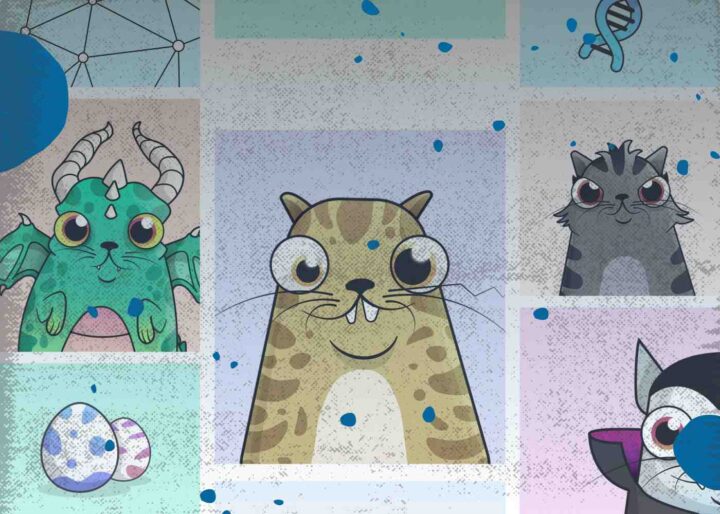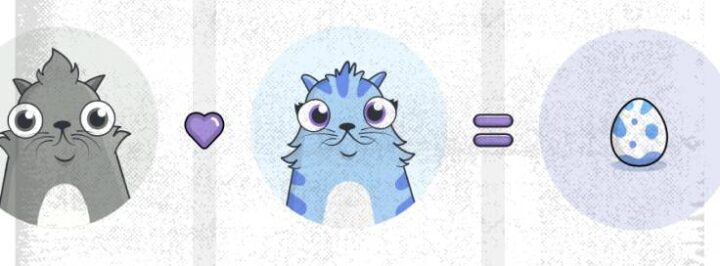CryptoKitties Online Game: Crypto Cats Phenomenon

The game is based on blockchain technology and Ethereum smart contracts. The app’s users spend real money to buy each kitty. Transaction volumes when exchanging kitties can amount to tens of millions of dollars.
The price of the very first kitty labeled with ID = 1 was a record amount of 247 ETH. The transaction took place on December 2, 2017 — the amount was more than $118 thousand at that time. If we talk about the cheapest kitties, today’s prices start from $0,4. Let’s take a closer look at what CryptoKitties are.
What Are CryptoKitties?

CryptoKitties is a game tracked on the Ethereum blockchain. The decentralized application is based on five smart contracts, and players interact with it via their addresses on the Ethereum network. The most convenient way to buy and sell cryptocurrencies is to use the MetaMask extension for Google Chrome. Using this extension, you need to go to the CryptoKitties official portal, which acts as an interface to interact with the smart contract to exchange cryptocurrencies.
At the moment, the app is the most popular in the Ether blockchain network — the game generates 10-15% of all cryptocurrency transactions — more than many common decentralized crypto exchanges. Unfortunately, such high traffic volumes lead to a significant slowdown in transactions, and the project has generally become a kind of predicament for the Ethereum ecosystem. The company has even been forced to raise “birthing” fees on kitties to keep blockchain traffic within acceptable limits.
How Does CryptoKitties Game Work?
The game’s developers created the first kitties, and then new pets were obtained by breeding. Owners can sell their cats at auctions, specifying starting and closing prices. Let’s assume that if the 24-hour auction puts the kitten at the starting price of 10 ETH and the ending price of 4 ETH and another player buys the crypto pet after 12 hours, he will have to pay 7 ETH.
The developers have introduced a breeding process in the game called siring (insemination). The owner of a male pet offers his “insemination” service to the owner of a female cat for coins. In this case, one player receives the earned Ether to his wallet, and the other gets a new crypto cat.
Any cat has a cooldown on re-breeding, the duration of which can vary from an hour to a week. The shorter the cooldown period, the higher the price of the digital animal. Each cat has a 256-bit genome to store the genetic sequence of its phenotype properties: character, color, presence of stripes, cooldown duration, etc. Some genes are recessive: for example, a one-color cat can give birth to striped kittens.
All cryptokitties are unique — there are about four billion variations available, with just over two million created so far. The pets are divided into common and rare types, but the game rules do not set the degree of a rarity for specific pet parameters. The value of many characteristics is determined by the community itself — players “vote” with coins. For example, cryptokitties with a gold background have the highest price. The owner can only change the name of the digital whiskery pet, which usually reflects the kitty’s valuable characteristics.
It is impossible to read all cats’ genomes, but the game provides a system of recommendations for breeding. In addition, the process is somewhat random so that a kitty can become more or less valuable than its “parents.” As a rule, early generation cats are worth more due to rarity and relatively short intervals between breeding.
Note that the developers have provided a commission of 3,75% for any transaction — purchasing, selling, or breeding of pets. But in accordance with the smart contracts, the exchange of cats is directly performed without charging a commission.
The Story of CryptoKitties

Vancouver-based startup Axiom Zen launched the online game in November 2017 on the Ethereum blockchain. ERC-721 tokens were initially used, and ERC-1155 tokens were applied later. The first 100 founder cats were generated programmatically. A few days after the app’s launch, a new Level 0 (Gen 0) kitty was created every 15 minutes. Their starting value was equal to 150% of the arithmetic average of the last five purchased crypto kitties, with the value dropping within 24 hours until any player bought a digital animal.
Some statistics:
- more than $3 million worth of pets were bought in the first week — the app’s traffic reached the 11% mark of total Ethereum transactions at that time;
- ten days later, $7 million worth of crypto kitties were sold;
- within a month of the app’s work, the number of users reached 180 thousand, and the total “value” of the pets exceeded $20 million;
- the number of users who wanted to get their own digital cat exceeded 1,5 million in three months.
The most expensive virtual kitty was sold in 2018 for $140 thousand. Today, the price of the most expensive crypto cat is 600 ETH, which is a little over $2 million, yet it hasn’t been able to find a buyer for about a year. As of early 2021, there were about 150,000 owners online.
The Future of CryptoKitties

Though CryptoKitties grew in popularity in the first six months after its launch, the hype around the game began to fade over time. Nevertheless, many investors and traders continue to hold crypto as pet assets to earn a larger sum on their sale in the future. Using smart contracts, Axiom Zen Studios continues to maintain and develop the decentralized app, improving its interface on different platforms and making it easier to get to know the game. However, interest in the game has a jumping-off point. For comparison, according to the CryptoSlam! service, the total sales of cryptocurrencies in August 2021 was $2,2 million, while in July it was only $168,000.











